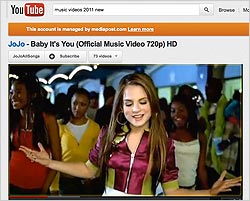 The total U.S. Internet audience viewed
43.5 billion videos in December, according to comScore. The data firm released video viewing numbers Tuesday morning indicating that 182
million U.S. Internet users watched online video content in December, for an average of 23.2 hours per viewer. While YouTube generated the most views, what can marketers do to build their brand as the
video site prepares to launch the 96 channels announced late last year?
The total U.S. Internet audience viewed
43.5 billion videos in December, according to comScore. The data firm released video viewing numbers Tuesday morning indicating that 182
million U.S. Internet users watched online video content in December, for an average of 23.2 hours per viewer. While YouTube generated the most views, what can marketers do to build their brand as the
video site prepares to launch the 96 channels announced late last year?
Google Sites, driven primarily by video viewing at YouTube.com, ranked as the No. 1 online video content property in
December with 157.2 million unique viewers. VEVO ranked No. 2 with 53.7 million, followed by Yahoo sites at No. 3 and 53.3 million views, Viacom Digital with 45.8 million, and Facebook with 42
million.
As YouTube prepares to launch the 96 channels announced last year, marketers wonder how to monetize the content they produce and post on their brand channel. To provide some
perspective to the enormity of YouTube's potential for brands, marketers should keep in mind the 48 hours of video uploaded every minute to the site -- resulting in nearly eight years of content added
daily, according to the site.
YouTube holds the title as the No. 1 video viewing site, but it's also the second-most-used search engine in the world. Videos posted to the site serve up in
Google and Bing universal organic search engine results. So how should search marketers approach YouTube as a channel for marketing goods and services, and what are the must-do tactics for the video
to get clicks? And why will it become important? Hint: brand channels, subscriptions, and continually refresh content.
Marketers who were asked about launching a video strategy said brands
should create a YouTube channel. Finding the correct keywords and optimizing the videos uploaded to the site comes next, according to both BrightEdge CEO Jim Yu and Chacka Marketing Founder Janel
Laravie, who said dropping cookies in the browser when visiting a YouTube channel can help brands remarket ads similar to Web site visitors.
Keywords can significantly impact when and how
videos serve up in universal search engine results, as well as the order in which they appear in YouTube results, Yu said. Even instructional videos within the same topic will vary. Marketers should
think of rankings in query results as "shelf space" in order to better understand the value of the position in the search query. "Shelf space" also reinforces the value in universal
search. Marketers need to be sure they have a strong presence across multiple media, including video. Having the same search topics can ensure a consistent brand
presence.
So what’s a must-do tactic for search marketers? Yu says that marketers must pinpoint the keywords triggering video search results, and then produce and optimize content
for those keywords.
Of course, it all comes down to the company's marketing, digital and business strategy. Russ Mann, Covario CEO, said a branded manufacturer of consumer electronics
that doesn't sell direct to consumers may want to build on brand awareness rather than conversions and sales. A direct-response merchant might want the company's Web site to become the video
destination, because those videos are likely to lead to conversions.
Marketers must have SEO best practices, according to Rob Griffin, EVP and global director of product development at Havas
Digital -- so it's important for advertiser to act like a publisher and continually refresh this content. It's not all that different than how to approach Facebook
campaigns, he said. Both have a blend of paid, owned, and earned media that an advertiser must leverage separately in order to create a unified branded
experience.
Since YouTube will likely offer a subscription model, brand channels will become more important. In an earlier interview, LongTail Video CEO Dave Otten said it's very easy to
imagine that YouTube will explore some type of subscription model, given Hulu's success with its paid subscription business, Hulu Plus, which had more than 1.5 million subscribers as of December
2011.
The success of a subscription program will come down to the exclusivity or uniqueness of the content offered on these channels, Otten said. YouTube dabbled a bit with subscriptions
last summer when it allowed users to watch England vs. India cricket matches live with a paid subscription, he added.
If YouTube does announce a subscription model, Otten expects it
to have little impact on the growth of online video advertising. Online video will have several business models, with advertising and subscription -- or PPV --likely being the most
common.
Today, only a relatively small percentage of content is available online. The majority of video content available will remain ad-supported, so Otten believes video advertising
will continue to grow. New subscription models will not be the biggest determinant of how rapidly video advertising grows. Rather -- and not surprisingly -- growth will come down to how well
video advertising performs for marketers, Otten said.